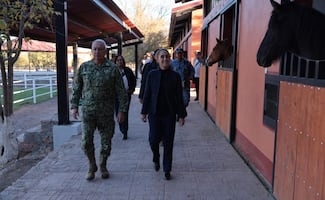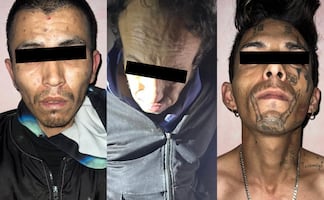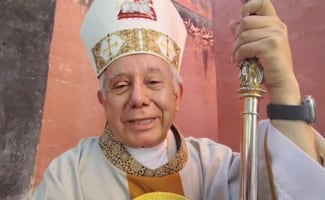Más Información

Padres y normalistas de Ayotzinapa marchan en Chilpancingo; acusan impunidad por asesinatos y la desaparición de los 43

Sheinbaum reconoce labor de las Fuerzas Armadas; hombres y mujeres que entregan su esfuerzo y su vida por amor al pueblo, destaca

Trump minimiza nuevas fotos con el pederasta Epstein publicadas por el Congreso; "no son gran cosa", dice

Recuperado, Ealy Ortiz retoma su liderazgo en EL UNIVERSAL; encabeza comida de fin de año de la empresa

Localizan a Yareth Alexandra, joven de 17 años privada de la libertad en Tecámac; la tenían escondida en una bocina
The ancient Ife sculpture seized in Mexico City’s International Airport that was returned to Nigeria in a ceremony at the Foreign Affairs Ministry is fake, according to an expert.
There was no need to examine it, the picture itself sufficed to know the piece was fake.
Julien Volper
, curator of the Royal Museum for Central Africa in Tervuren , Belgium , talks about the cultural heritage restored by Mexico to Nigeria and that allegedly came from the Ife culture, the native land of the Yoruba people.
“This piece is fake , completely fake, and it was really easy to come to that conclusion,” said to EL UNIVERSAL the also adviser of the police, customs office, and courts that manage cases related to objectives of ancient cultures in Central Africa.
Recommended: Mexico returns Yoruba archeological piece to Nigeria
He asserts that there are different imitation levels : There are objects that are very hard to differentiate due to the details and finishes and those that can be identified as mere artifacts from far.
“[The piece delivered by Mexico] corresponds to the last case, it’s quite simple, the aspect, the style, and the patina (the greenish rust that forms in bronze and other materials due to humidity),” he asserts.
“I would never make a declaration in that sense if I weren’t 100% sure. This piece is completely fake , no doubt,” he stresses.
He says that any expert, curator, collector, and merchant of African art that observes the piece can conclude the same.
“Honestly, it was enough to see it,” he admits. He says that 80% of the cases of fake artifacts from Central Africa are usually identified through pictures.
Recommended: Archeological looting in Mexico
Last February 25 , the deputy minister of Foreign Affairs Julián Ventura gave Nigeria’s ambassador in Mexico Aminu Iyawa a bronze sculpture that had been allegedly authenticated as cultural heritage of the African country.
The piece had been seized at Mexico City’s International Airport and pretended to arrive at its destination via mail.
“For Mexico, the recovery of looted cultural heritage is a priority. We are against the illegal commercialization of archeological pieces, an important cause of the impoverishment of the cultural heritage of the countries of origin for it undermines the integrity of cultures and, hence, of humanity,” said Ventura back then.
The ethnography curator of French origin ignores how it was that Mexico concluded that it was an authentic object, although he says that it was perhaps due to a lack of knowledge of African art.
“They are used to work with Mexican and pre-Columbian art but perhaps not with African art. The biggest mistake was to give that job to people who are not specialized in African art; I see no other reason.”
Recommended: Mexico recovers rare 500-year-old coins located in the U.S.
About the Nigerian authorities, he says it is a reflection of the lack of capacity as well as of experience in the management of objects.
“R estitution has become a trend for politicians,” he says.
“Many are inclined to restitution from the ethic and moral perspective, but ethics and moral do not give you the required experience level. When we talk about the restitution of pieces, you need to know about national and international law and know the objects and their history ,” he mentions.
The History of Art expert stresses the great experience and tradition of Belgium and France in terms of cultural heritage from Africa.
Julien Volper adds that there is a great amount of African “touristic art” in the market; the problem lies in that many of them are sold for thousands of euros by claiming to be authentic.
Recommended: Mexico recovers archeological pieces located in Germany
The verdict and the official act
In a ceremony that took place at the Foreign Affairs Ministry on February 25 , the repatriation of the piece became official.
There, Diego Prieto , director of Mexico’s National Anthropology and History Institute (INAH) said the process was made with a verdict by Raffaela Cedraschi from the National Museum of the World’s Cultures .
The verdict, to which EL UNIVERSAL had access, consists of 27 pages and is divided into five sections: General Matters, Particular Matters, Authenticity Matters, Conclusion, and Bibliography.
However, since the beginning, Cedraschi says the analyzed sculpture “quite probably corresponding to the Ife Kingdom-State of current Nigeria , Africa ,” an idea she reinforced at the end:
“We concluded that this piece can have a questionable origin and be a product of some kind of archeological looting , pillage, and/or trafficking of ancient objects. We consider it necessary, hence, to consider it as a cultural heritage of relevance for Nigeria’s Yoruba people.”
Recommended: Once again, French auction house to sell Mexico's cultural heritage
The researcher complements her text with three recommendations with which it can be confirmed that the sculpture is authentic . The first consists of the sculpture to be kept under the safeguard of the National Museum of the World’s Culture while there are still doubts on its origin so as to also conserve it as best as possible.
“For the sculpture to be evaluated by an Ife art expert like Henry John Drewal (University of Wisconsin) or Suzanne Preston Blier (University of Harvard), or any other expert recommended by the International Council of Museums (ICOM) , notifying, in addition, the seizure of the piece at issue,” writes Cedraschi.
In the last point, she considers it necessary for the piece to be put under “a more specific analysis about its structural composition, such as metallography and metal dating known as particle voltammetry .”
Before undergoing these considerations, Raffaela Cedraschi made an analysis of the piece from a comparative study with pictures from different books and websites, with which she obtained the characteristics the sculpture shares with others from the region found in different moments.
Recommended: The hidden splendor of Mayan city X'batuún
The bronze sculpture represents a sitting human being with an accessory in the waist, necklaces, bracelets, anklets, and “a central headdress.”
“So far, we have not been able to identify, among the sources, the object held like a scepter in the hands of the piece: It could be a hand closed in a fist with the thumb extended or the representation of a five-finger paw of the mythical rooster that spread the earth over the water and created the world; nevertheless, this piece seemingly has the marks of six fingers. Something similar happens in several Ife sculptures that have it in one hand while on the other, they have a horn with protection medicines,” reads the document.
Regarding the date of the piece, the expert recognizes “it’s very hard to date Ife culture pieces because most objects were found in very different places from their place of origin,” Moreover, she adds that the sculpture is made with “the so-called copper alloy .”
The piece sought to enter Mexico via mail from the Pan African Market Shop (Capetown, South Africa) , “a market similar to Mexico City’s Ciudadela where, in different shops, all kinds of crafts from Africa are sold. According to the pictures found on the Internet, the place doesn’t seem to offer any kind of authentic or ancient ethnographic pieces,” explains Cedraschi.
Almost by the end of the verdict, the INAH researcher points out that, after analyzing publications and news online “we ignore if the analyzed piece could have been found in an archeological site in Nigeria and then reproduced with the technique of lost wax and perhaps buried to make it have the patina it now has.”
Despite the recommendations by Raffaela Cedraschi , the repatriation took place as mentioned before.
Among other things, Nigeria’s Embassy in Mexico was asked whether they collaborated to verify if the piece was authentic and if the piece is in Mexico but there was no response.
Nigerian ambassador Aminu Iyawa
studied at Columbia College Hollywood ; he has two postgraduate courses, one in public relationships at The Management School in London, and another in journalism by the Robert Gordon University in Aberdeen, UK.
From 1977 to 2007 , he worked in different media outlets like Nigeria’s television, he was an editor at Abeotuka’s radio, and a news editor in Yola’s television, as well as in organisms like Yola’s Information Ministry.
In 2007 , he worked as a Special Advisor of the governor of the Adamawa State and from 2012 to 2014 , he was a Commissioner at the Rural Infrastructure Ministry of the same place.
In 2016 , Nigeria’s President Muhammadu Buhari designated him as ambassador, an appointment that was approved by the Senate in February 2017 . Mexico is his first embassy, which he leads since 2018 .
Recommended: Mexico still in debt with Honduran cultural heritage
mp
Noticias según tus intereses
[Publicidad]
[Publicidad]









